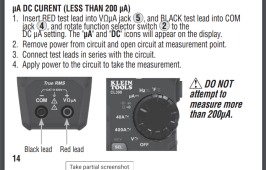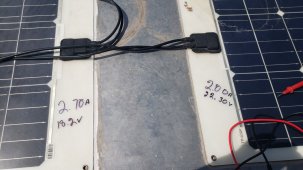Bud Martin
Solar Wizard
- Joined
- Aug 27, 2020
- Messages
- 4,844
Well, that is why your reading is wrong, if you look at the meter probe terminals, you will use red and black probe wire when you try to measure current in uA only, otherwise you use clamp for higher current readings.I set the multi meter to dc amps red probe to the red wire in the connector and black probe to the black wire of the connector
Please read the meter manual, and I hope you did not damage the meter and hopefully the meter fuse should have blown when trying to use the probe wires measuring high current in Amp range to protect itself, the probes are for up to 200uA measurement only.
See:
Page #10 for high current reading.
Page #14 for low current measurement. See warning: DO NOT attempt to measure more than 200uA!

Last edited:




